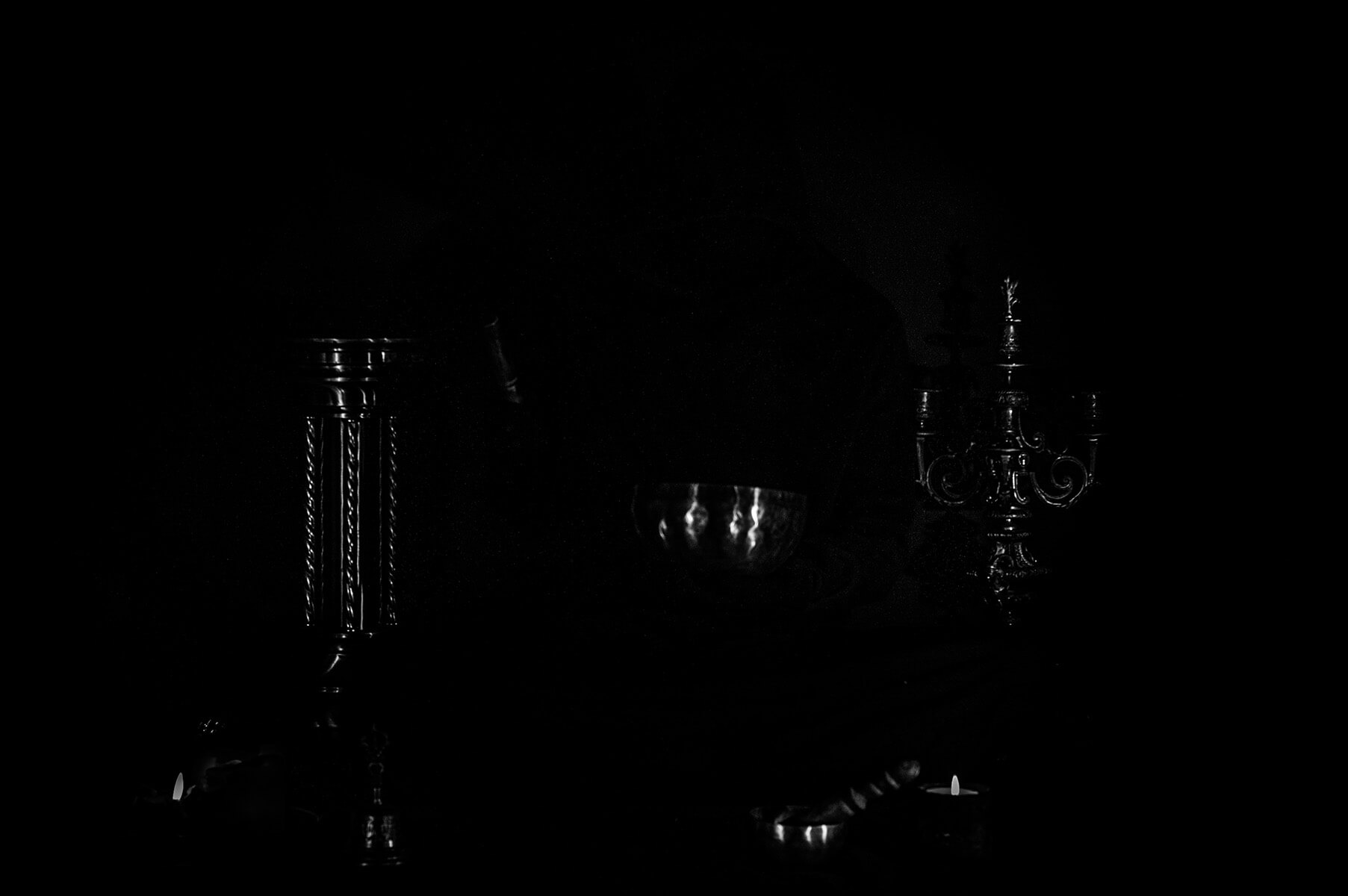Cultural evolution and experimentation represented in organically growing ritualistic soundscape
- ꜜ Origin ꜜ Symbolism ꜜ Label ꜜ Musical direction ꜜ Sound ꜜ Transcendence
I
Origin
Before digging deep into Muur; what does Muur mean, especially knowing that in an English dictionary Muur carries the following meaning – An onomatopoeic phrase describing the general discontentment and sullen melancholic disposition of one’s self towards an object, a person/state.
MUUR was not taken from English, nor any terrestrial language for that matter. While the auditory elements obviously make up the principal part of the final product BOD, the process to arrive there required a great number of antecedent inventions.
One avenue of fabrication was linguistics, as I wanted MUUR not to continue on some current path, scene, or even culture, natural or fictional. Because of this desire to start anew, I spent a long period on study and preparation. I invented a new people, which necessitated a new geography, history and an ever evolving, naturalistic language.
The word MUUR was taken from a proto-stage of the language spoken on BOD, with a sacred meaning for those performing the ritual.
How was Muur born into this world? And what was the aim with this specific ambient ritual soundscape, especially that a country like the The Netherlands is not very famous for that type of sound?
MUUR was not born, but grown organically; fermenting and forming in my subconscious. I have long had an interest in anthropology, philosophy, ethnomusicology and linguistics.
Through my studies in these fields I was exposed to many sounds, forms and ideas that were unfamiliar to me, having been raised in the tradition of Western thought and music.
Because of the way it developed, the aim of the work is to be found entirely within its creation; its meaning to be decided upon by the observer. It is not for any definable reason, it merely is. Additionally, as it draws from a wide variety of sources – cultural and fantastical – MUUR cannot be tied to any one physical location.
What music have you been brought up listening to? In which do you think it influences Muur’s soundscape?
While I was raised on Western music, starting at Bach and ending at the hard-rock of the 1980s, my travels and explorations have exposed me to many different sounds. This started during my adolescence as an exploration of alternative scenes, such as punk and metal, but also avant-garde jazz and experimental contemporary classical music.
From there my curiosity and thirst for novelty spurred me on to seek historical, liturgical sources, such as Gregorian or Byzantine chanting. From there the leap to various other traditional styles, such as throat singing from Tuva or the Raga of Indian classical music.
Thus, liberated from the shackles of my Eurocentric musical upbringing, I was free to experiment and explore many niches and subgenres of niches I have not mentioned. I think in this way the journey matters more than its stations, as all elements of this experiment have influenced MUUR’s soundscape to a greater or lesser extent.
What books and authors arouse your interest, and similarly might have helped in shaping Muur’s spiritual entity?
I feel that focusing on my influences and interests, however compelling to my ego, might also serve as a distraction from that what demands focus. I might, in a manner similar to our discussion on my musical influences, name authors, genres, time-periods and cultures that have fascinated me at one time or another.
However, I fear that in doing so I would be complicit in creating a narrative where the meaning of a work may be sassed out through the study of its parts. This would run completely counter to my firm belief that a work must transcend its history, forcing the observer to grapple with the radically free notion that true meaning may only ever be generating by the individual.
II
Symbolism
Symbolism is a strong factor when it comes to the band’s figurative identity, can you elaborate on that?
As the culture evolved, so did its system of beliefs. This involved a number of ritualistic practices, of which some may be heard on BOD. Besides documenting the sounds produced during these practices, I also wished to share the symbols that are of great importance to those performing the ritual.
For them, as is often the case in ritual, the original meanings and intentions behind the symbols have been repeated, misremembered, forgotten, unearthed and awarded the spirit of sacred mystery.
Most importantly, however, I am wary about divulging too much about the cultural, symbolic and linguistic elements present in the work, as I strongly believe these to be moot when it comes to experiencing the performance. They are vital to the process of creating, but can become hindrances in the process of perceiving. It is imperative for the beholder to grapple for themselves with the gift and curse of free signification.
III
Label
Muur is an independent artist; were you approached by labels wanting to sign you? What is the concept behind your independence?
MUUR is independent by necessity. As I am not in control of the process of creation, I can give no guarantees on what MUUR will produce next, or whether it will ever even produce again at all.
I follow my process and guide where I can, which makes it so that I can never keep to a schedule. After the completion of BOD, I was fortunate to find a partner in Cyclic Law to aid me in materializing my vision.
What is behind the limited copies of DigiSleeves; which is actually 500?
Together with Cyclic Law, we wanted to make sure the final product was of high quality. Buying physical music is a rarity today, which is understandable given the innumerable releases that appear each moment. If any individual were to decide to acquire for themselves this album, I wanted the quality of the product they received to reflect to them my honor in them having purchased it.
We felt that, as DigiSleeves carry print very well, this would be the best option. Limiting the release to only five hundred copies seemed prudent to me, as I do not expect this project to have mass appeal. It was made through itself, for itself, with no regards to a possible audience.
IV
Musical direction
On Muur’s Bandcamp page, you have mentioned that the band is not affiliated with any form of traditional Left-Hand Path…Why did you have to make that clear?
I remember first discovering the genres of ritual ambient and dark ambient. I had not, at that point, heard any of the material it had to offer, but I found the name evocative. I felt this label could be home to a great variety of sounds and experiments, performing rituals through every possible way of interacting with the spiritual.
However, upon hearing the actual works within the niche, I quickly found there was a clear pattern of using similar ideas and sounds. One of the main things I found was that there was an abundance of acts invoking the imagery and symbolic traditions of the Left-Hand Path of Western esotericism. While this tradition is certainly rich and deep, I was disappointed with the lack of deviation from it.
When BOD was completed, I could see how it might be labeled as ritual or dark ambient and wanted to immediately set it aside from the expectations that I had seen come with that. Consider it a disclaimer to prevent disappointment in those looking to confirm or strengthen what they are familiar with.
V
Sound
How does Muur define sound? And how is that definition represented in your aural frequencies?
I am not in the business of defining or redefining words that already exist, but am far more interested in inventing new ones, or the macroscopic processes of language. Because there was no plan to create a specific sound, I spent very little time intellectually searching for one.
The sounds present on BOD all came about organically, through experimentation and cultural evolution. This is why the work is simultaneously minimalist and intricately detailed.
Every element has its own, internally obvious timing and placement in the performance. Every decision followed from what came before, every fundament is based on attested and documented cultural practices.
What is the story behind the BOD release? And what does it address with its ritualistic ambience that is mixed with open chord drone-like sound distortion and chants of the sacred sound of the universe?
BOD is a direct result of years of exploration of my fascinations. Its creation was a continuous process of alternating between free experimentation and rigorous refinement of both the vision and the sound. It was never necessarily my intention to start a musical project or create an album, but in experimenting with sounds – familiar and invented – eventually a ritual formed.
As such, it consists of a single performance that is a whole unto itself. I wasn’t planning on this outcome, but once the project was completed, I felt there could be no other. This is the album that both my audience and me have been presented with.
VI
Transcendence
What is transcendence to Muur?
In my vision to start anew, perhaps I hoped to transcend that what is and has come before. By letting the process of evolution take its course, I feel the resulting ritual is both familiarly and organically human, while also being remarkably and unquantifiably alien.
However, as I’ve stated before, the most important thing to me is that people decide on definitions in the ritual – symbolic and otherwise – for themselves. If one chooses to listen to MUUR, one is condemned to freedom.
I do not care what people decide what the project is about, so long as they choose their truths for themselves.

